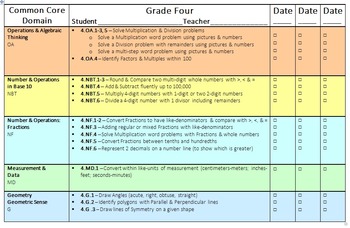Fourth Grade Common Core Math Assessment: Benchmark or Diagnostic
Mathemagicians and Word Wizards Enter Here
89 Followers
Grade Levels
2nd - 5th
Subjects
Resource Type
Standards
CCSS4.MD.A.1
CCSS4.NBT.A.1
CCSS4.NBT.A.2
CCSS4.NBT.A.3
CCSS4.NBT.B.4
Formats Included
- PDF
Pages
9 pages
Mathemagicians and Word Wizards Enter Here
89 Followers
What educators are saying
This is a great assessment to use to find out where your students are at in all the math strands. I trach math intervention k-6 and have this assessment tool for all grade levels.
Covered the skills for a great diagnostic tool! Used it for my tutoring to see where students fall and what gaps they need covered.
Description
Mathemagicians and Word Wizards Enter Here for a Fourth Grade Common Core Math Assessment. This test has multiple intended uses. Including:
1. Ensuring an end of the year 4th grader mastered all the Common Core Standards. (Summative Assessment)
2. Ensuring a beginning 5th grader mastered each of the 4th grade Common Core Standards (Summative Assessment)
3. Placing a 4th grader into an enrichment group. (Screening Assessment) and
4. Determining intervention areas needed to be covered for a student with specialized designed instruction.
(Diagnostic and Progress Monitoring Assessment)
1. Ensuring an end of the year 4th grader mastered all the Common Core Standards. (Summative Assessment)
2. Ensuring a beginning 5th grader mastered each of the 4th grade Common Core Standards (Summative Assessment)
3. Placing a 4th grader into an enrichment group. (Screening Assessment) and
4. Determining intervention areas needed to be covered for a student with specialized designed instruction.
(Diagnostic and Progress Monitoring Assessment)
Total Pages
9 pages
Answer Key
Included
Teaching Duration
30 minutes
Report this resource to TPT
Reported resources will be reviewed by our team. Report this resource to let us know if this resource violates TPT’s content guidelines.
Standards
to see state-specific standards (only available in the US).
CCSS4.MD.A.1
Know relative sizes of measurement units within one system of units including km, m, cm; kg, g; lb, oz.; l, ml; hr, min, sec. Within a single system of measurement, express measurements in a larger unit in terms of a smaller unit. Record measurement equivalents in a two-column table. For example, know that 1 ft is 12 times as long as 1 in. Express the length of a 4 ft snake as 48 in. Generate a conversion table for feet and inches listing the number pairs (1, 12), (2, 24), (3, 36),...
CCSS4.NBT.A.1
Recognize that in a multi-digit whole number, a digit in one place represents ten times what it represents in the place to its right. For example, recognize that 700 ÷ 70 = 10 by applying concepts of place value and division.
CCSS4.NBT.A.2
Read and write multi-digit whole numbers using base-ten numerals, number names, and expanded form. Compare two multi-digit numbers based on meanings of the digits in each place, using >, =, and < symbols to record the results of comparisons.
CCSS4.NBT.A.3
Use place value understanding to round multi-digit whole numbers to any place.
CCSS4.NBT.B.4
Fluently add and subtract multi-digit whole numbers using the standard algorithm.


